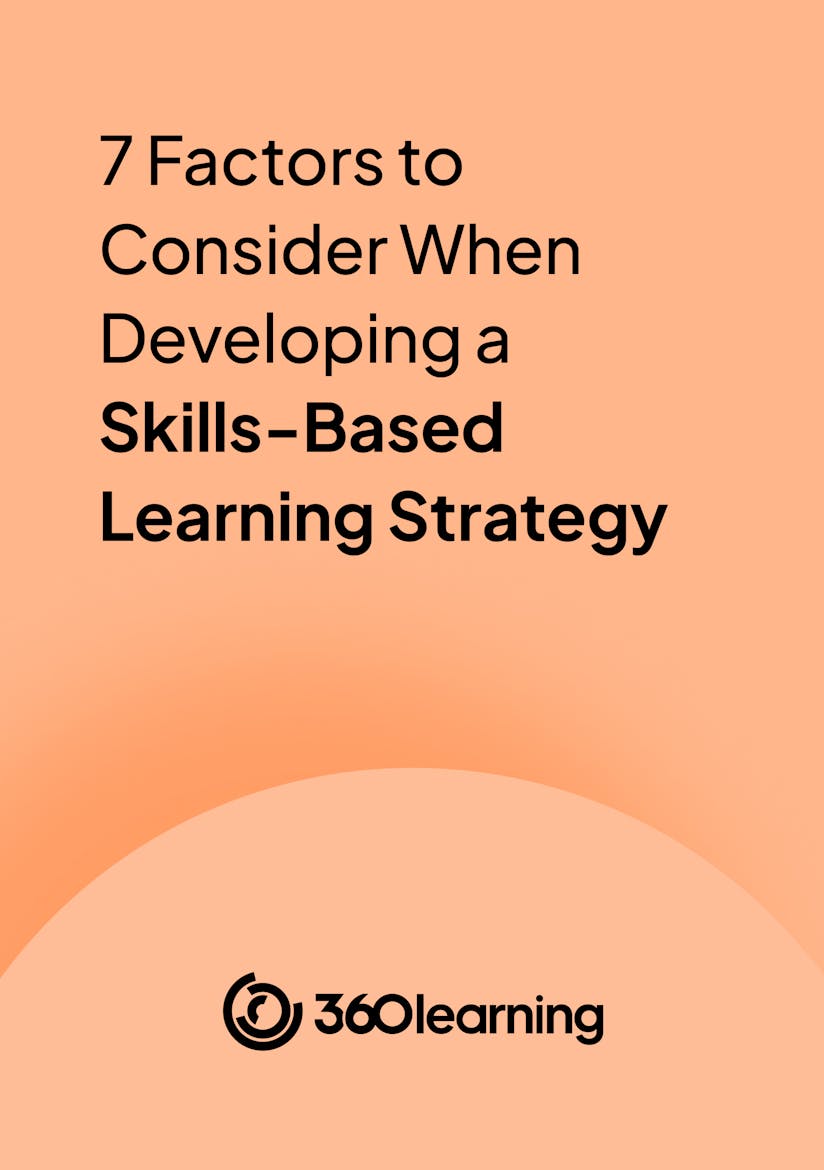
The launch of Skills England was announced by Prime Minister Keir Starmer in July 2024. It’s a new government agency tasked with delivering serious policy changes to close the UK’s significant skills gaps, and grow the economy.
It’s brand new, and much is still unknown about what it will do and how organizations can contribute or benefit. But L&D leaders should take note: skills-based learning and development is the major focus.
This article unpacks the goals and purpose behind Skills England, why skills are at such a premium in the UK, and what it all means for your organization.
Note: This article concerns emerging government policy. Details are accurate as of September 2024, but many of the proposals explained have yet to be finalized.

Guarantee a successful move to skills-based L&D
By providing your contact info, you agree to receive communications from 360Learning. You can opt-out at any time. For details, refer to our Privacy Policy.
What is Skills England?
Skills England is a body created by the new Labour government to address the current UK skills shortage. It brings together local and central government, unions, businesses, and training providers to close these nationwide skills gaps.
Skills England will eventually replace the Institute for Apprenticeships and Technical Education, which currently helps employers on technical qualifications and apprenticeships.
The goals of Skills England are to:
- Identify skills gaps at the national level, and create strategies to address them. These strategies may involve changing migration and immigration policy, and industrial reform.
- Unify the skills landscape in England, in collaboration with local government, businesses, unions, and training institutions.
- Update technical training to meet skills needs, and make specific training available through the Growth and Skills Levy.
- Create a long-term plan for economic growth that factors in the skills needed by the future workforce.
Skills England will also determine where funding is allocated, in particular for apprenticeships and government-funded training courses. The existing Apprenticeship Levy will evolve into the Growth and Skills Levy, in the hopes of making this funding more flexible.
The hope is to have the agency fully up and running by Summer 2025, with many proposed changes taking effect before then.
What is the Growth and Skills Levy?
The Growth and Skills Levy will replace the existing Apprenticeship Levy. Employers can still use these funds to offer apprenticeships, but a proportion can be allocated to non-apprenticeship training.
The goal is to let businesses use these funds more effectively. Currently, only 55.5% of the available apprenticeship funds are actually used, suggesting that apprenticeships aren’t always the answer organizations need.
What is the UK skills shortage?
As the Prime Minister himself said, “Our skills system is in a mess, which is why we are transforming our approach to meet skills needs over the coming decades. Our success as a country depends on delivering highly skilled workforces for the long-term.”
The Department for Education found that skills shortages doubled from 2017-2022. They reportedly account for 36% of UK job vacancies, and are felt most acutely in the construction, IT, healthcare, and engineering sectors.
The UK is one of the most “under-qualified” countries in the OECD. 26% of workers lack the necessary qualifications for their occupation—only Ireland and New Zealand rank lower.
What are the current skills challenges in the UK?
According to Skills England’s first report, the key concerns include:
- Skill mobility. Two-thirds of graduates work in inner London, which “can hinder an efficient allocation of talent and expertise” across the rest of the country.
- AI and automation. All regions identified AI and automation as emerging skills priorities.
- Mismatched skills. The report found “clear evidence of a gap” between the skills employers are looking for, and those that prospective employees possess.
- Lack of transferable skills. These are the capabilities that make people high-functioning team members, no matter the role. They involve collaboration, creative thinking, leadership, digital skills, numeracy and writing.
- Shortage of training supply. Employer demand for technical skills is growing, but the proportion of people in England pursuing this training is much lower than Germany, Canada, and other OECD countries.
- Low private investment. Skills England calls on employers to invest more in workforce training and on-the-job skills development. Training spend is reportedly at its lowest level since 2011.
Average employer spending on training has fallen by 27% since 2011, at least in part because of how funding is allocated via the Apprenticeship Levy. British Retail Consortium head Helen Dickinson says “retailers want to invest more in training a higher skilled, more productive and better-paid workforce. They want to create more opportunities for people up and down the country. They want to contribute more to growth. But the broken apprenticeship system is a ball and chain around their efforts.”
Hopefully an emphasis on continuous learning—not just for apprentices—will bring real change.
The Immigration Salary List
The government keeps a list of specific occupations that qualify for skilled worker visas. In other words, these are the jobs that can’t be filled domestically at present.
While Skills England’s remit is broader than simply filling these roles, the government has stated that better skilling will mean less need for immigration to grow the economy.
Jobs on this list include:
- Biologists, archaeologists, laboratory technicians, and pharmaceutical technicians.
- Artists, musicians, producers and directors.
- Welders, bricklayers, stonemasons, roofers, and carpenters.
- Care workers, animal care services workers.
This by no means excludes training for other occupations from the overall policy agenda. But clearly these skills are in short supply today.
How Skills England impacts organizations
The ultimate goal is to promote economic growth through a highly-skilled and competent workforce. So organizations stand to gain, and will be a key player in this transformation.
There are three key ways that businesses can expect to interact with Skills England:
1. Setting the agenda
Before delivering final policy proposals, Skills England will consult with businesses to discover their specific skills shortages and the best ways to fill these. Organizations can and should participate in this consultation process.
This is particularly important if you:
- Have a limited need for apprenticeships. If you want to see greater focus on non-apprenticeship training, your voice must be heard.
- Are a small business. The Apprenticeship Levy and associated scheme are best suited to large organizations. Small businesses still risk being underfunded and overlooked in the new regime.
- Care about a wide range of skills. While Skills England have acknowledged transferable, non-technical skills as important, technical skills are often easier to measure and therefore prioritized. It’s also critical to highlight different learning styles and learning delivery methods.
Skills England needs to hear from companies of all sizes and sectors to shape its policy agenda. If you care about developing employee skills, this is your chance.
2. Directing funding
As mentioned above, more funding will soon be available for non-apprenticeship training. It’s likely that this will apply to a list of pre-approved training courses. Organizations should therefore ensure that their preferred courses and training providers are included in that list.
But once in place, businesses can use these funds to upskill and retrain employees. This should hopefully have a positive impact on organizational learning and development programs, and make it easier to justify these internally.
3. Continuing to invest in L&D
While the Growth and Skills Levy and associated courses will be a welcome change, they’re just a part of a robust L&D strategy. You can and should invest in your own employee training programs to gain a competitive advantage and retain staff for longer.
This feeds back into the government’s skills policy. When it sees the success of more tailored approaches to learning, it will be more likely to provide additional funding in future.
And of course, the new policies will take time to come into effect. Smart companies will take advantage of what’s available, without waiting to take action today.
What Skills England means for learning and development
As John Cope writes, “A new agency can galvanize activity. It can coordinate action across the government. Provide the opportunity for innovation. Inject new expertise. And it can offer a very clear signal of ministerial priorities.” There’s reason to be optimistic and excited about this renewed focus on skills.
The benefits for the skills sector include:
- A standardized skills taxonomy. This was already planned, but Skills England has promised to deliver a “UK Standard Skills Classification” to describe and measure skills across the jobs market.
- More responsive skills policy. Skills England is a cross-government body that must consult with industry and training professionals. This should result in dynamic skills assessments that more accurately reflect the needs of the economy.
- Focus on domestic skills. The hope is to upskill British workers to reduce the reliance on immigration and imported skills.
- Local priorities. More training opportunities will be available to address shortages outside central London, and particularly in rural and industrial areas. Skills England will collaborate with administrations in Scotland, Wales, and Northern Ireland to boost growth throughout the UK.
- More funding for skills training. Funds will go towards reskilling and lifelong learning, and won’t be concentrated only on apprenticeships and internships.
- Better skilling at all levels. Instead of the current focus on apprenticeships, organizations will be able to build programs for all age groups and experience levels. A key example is digital literacy, a crucial skills gap which is often a challenge for older generations.
That final point is really the key for L&D professionals. You’ll soon have more flexibility in how your company can use the Growth and Skills Levy. Whether this will include in-house training remains to be seen, but you’ll be able to complement your own programs with government-approved courses.
Skills-based learning is the clear priority
We’re in the middle of a fundamental shift in the way organizations think about talent. L&D leaders already knew this, of course. Smart businesses have also come on board, and reshaped their training programs to concentrate on skilling.
And now the government has made upskilling and reskilling the focal point of its growth agenda.
Whether through higher education, apprenticeships, technical courses or on-the-job training, skill development is now a national prerogative. As corporate L&D professionals, let’s do our part to deliver programs that put skills-based learning front and center.

Guarantee a successful move to skills-based L&D
By providing your contact info, you agree to receive communications from 360Learning. You can opt-out at any time. For details, refer to our Privacy Policy.



